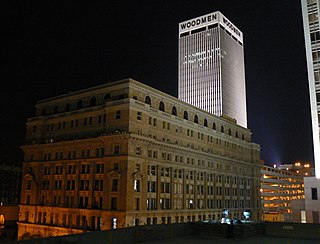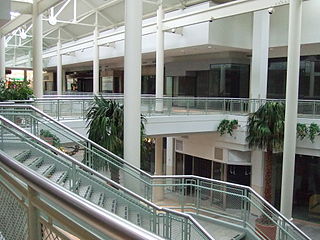
Lincoln is the capital of the U.S. state of Nebraska and the county seat of Lancaster County. The city covers 100.4 square miles (260.035 km2) and had an estimated population of 294,757 in 2023. It is the state's second-most populous city and the 71st-largest in the United States. Lincoln is the economic and cultural anchor of the Lincoln Metropolitan and Lincoln-Beatrice Combined Statistical Areas, home to 361,921 people.

Dillard's, Inc. is an American department store chain with approximately 267 stores in 29 states and headquartered in Little Rock, Arkansas. Currently, the largest number of stores are located in Texas with 57 and Florida with 42. The company also has stores in 27 more states; however, it is absent from the Northeast, most of the Upper Midwest, and most of the West Coast, aside from three stores in California.

Joske's, founded by German immigrant Julius Joske in 1867, was a department store chain originally based in San Antonio, Texas. In December 1928, Hahn Department Stores acquired the company along with the Titche-Goettinger department store of Dallas, and three years later Hahn became part of Allied Stores. Allied was taken over by Campeau in 1986, and Campeau in turn sold the Joske's chain in 1987 to Dillard's. All Joske's stores were then quickly converted into Dillard's locations.

Maison Blanche was a department store in New Orleans, Louisiana, and later also a chain of department stores. It was founded in 1897 by Isidore Newman, an immigrant from Germany.

The Shops at Rivercenter is a shopping mall located in Downtown San Antonio, Texas, United States along the city's River Walk. The anchor stores are H&M and AMC Theatres. It also includes a 38-story, 1,001-room Marriott hotel. It was purchased in 2005 by Ashkenazy Acquisition Corporation.

J.L. Brandeis & Sons, commonly referred to by Midwesterners as Brandeis, was a chain of department stores located in the Omaha, Nebraska area started by Jonas L. Brandeis in 1881. It was purchased by Younkers for $33.9 million in 1987, when the stores were converted to the Younkers name.
Cain-Sloan Co. Inc. was a department store chain based in Nashville, Tennessee, United States. It was founded in 1903, merged with Allied Stores in 1955, and with Dillard's in 1987. It was a target of the 1960 Nashville sit-ins.

Crossroads Mall was an enclosed shopping mall located in Omaha, Nebraska, United States, at the intersection of 72nd and Dodge Streets. Originally opened in 1960 by Omaha's Brandeis department store, the mall has been home to several major chains, including Sears, Target and Dillard's before the store closed in 2008. The mall is now demolished, and is expected to be redeveloped as a mixed-use center, called The Crossroads, in 2025.
Gateway Mall is an enclosed shopping mall located in Lincoln, Nebraska managed by WPG. It was built in 1960, and is the largest shopping center in Lincoln, with 107 stores. The mall's anchor stores are Dillard's, Dick's Sporting Goods, Round 1 Entertainment, and JCPenney.
John A. Brown was an Oklahoma department store chain. It operated under that name from 1932, when its founder bought out its predecessor and renamed the chain for himself. After Mr. Brown died in 1940, his widow took over management until her own death in 1967, forcing a change in ownership. Dayton-Hudson, another retail company, continued operating the chain under the Brown name, until 1984, when Dayton-Hudson sold the Brown chain to Dillard's, another national chain, which combined all of the Brown stores under its own name. The flagship store on West Main Street was closed in 1974 and was subsequently razed as part of an urban renewal project. The project was supposed to result in a new shopping center known as the Galleria. However, the project was never completed, so the Brown chain never returned to downtown.

George Anthony Berlinghof was a German-born architect who designed a number of important buildings in Lincoln and other cities in Nebraska. Some of his surviving works are listed on the National Register of Historic Places.
Conestoga Mall was an enclosed shopping mall in Grand Island, Nebraska. It was opened in 1974 and is owned by Woodsonia Real Estate. The mall's lone anchor store at the time of closure was Best Buy. Previous anchor stores included Sears, Dillard's, Younkers and JCPenney.

Lincoln, Nebraska has many neighborhoods, including 45 recognized by Urban Development, City of Lincoln. A list and description of neighborhoods within Lincoln city limits follows.

Lincoln, Nebraska is the home of the state capitol of Nebraska, the University of Nebraska and has history dating back to the mid 1800s. A list of tourist attractions that can be found within the city are as follows.
The history of Lincoln, Nebraska began with the settlement of the village of Lancaster in 1856. The county of Lancaster was founded in 1859. Prior to settlement from the westward expansion of the United States, Plains Indians, descendants of indigenous peoples who occupied the area for thousands of years lived in and hunted along Salt Creek. Settlers first came to extract salt from the wild salt flats of Salt Creek. Nebraska was granted statehood March 1, 1867. Soon afterwards a commission created by the State was appointed to locate the State Capital on State lands. The village of Lancaster was chosen for the Capital of Nebraska. The village of Lancaster became Lincoln. Lincoln was named after Abraham Lincoln. The first State Capitol was completed in 1868. Lincoln incorporated on April 1, 1869.
The following is a timeline of Lincoln, Nebraska history including significant social, political, cultural, and economic events in the history of Lincoln.
George A. Berlinghof and Ellery L. Davis, Nebraska based architects, were inspired by neoclassical style and the architecture of the Chicago skyscrapers. After working in Beatrice, Nebraska, Berlinghof moved to Lincoln and started his influential relationship with Davis. Berlinghof gave Davis the credibility to launch his career. During their partnership (1911-1917), they designed more than twelve buildings together, most of which are still in use to this day, solidifying their importance in American Midwest architectural design of the early 20th century. They were a major part of the move towards historicism in Nebraska. By bringing neoclassical and romantic, victorian architecture back, the firm started a trend of design that referenced former architectural periods in Lincoln and surrounding areas.. Berlinghof and Davis worked together for a period of 6 years, wherein they designed many note-worthy structures for Nebraska that are still in use today including Lincoln High School, Miller and Paine Department Store and the Security Mutual Building.Most of the buildings designed by the Berlinghof and Davis Firm are still in use today. Though some, like the University of Nebraska-Lincoln Law Building, have been remodeled and repurposed, the outer facades still remain as tribute to the original design. Some of their designs are now listed on the National Register of Historic Places and many drawings and plans are kept by the Nebraska Historical Society. Though the firm of Berlinghof and Davis was disbanded shortly after conception, the amount of work achieved in that time was not only impressive in quality but also vast in volume.
Marston's was a department store based in San Diego, California, and founded by city leader George Marston. It had a downtown main store on Sixth Street and opened two suburban branches before being sold to The Broadway in 1961.

Runza Restaurant is an American fast food restaurant chain in the Midwestern United States whose flagship menu item is the runza sandwich.













